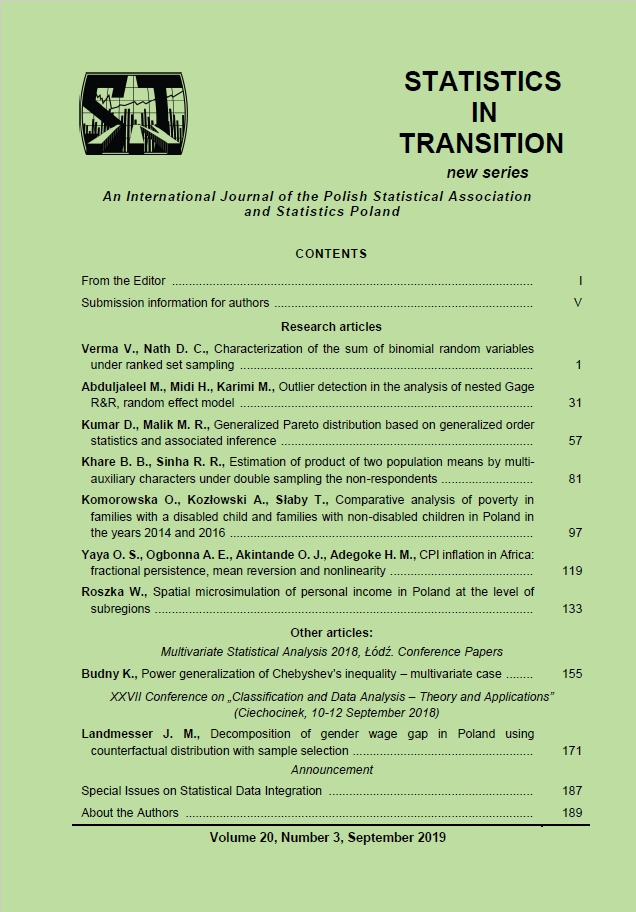ARTICLE
ABSTRACT
In this paper, we examined the characteristics of the sum of independent and non-identical set of binomial ranked set samples, where each set has different order depending success probability. The characterization is done by establishing the general recurrence relations for two different situations based on the number of cycle, which is initially pre-assumed as a constant integer and when it is a random variable. To extend the knowledge about the characteristics of sum in terms of their behaviour and pattern, first four moments i:e:; mean, variance, skewness and kurtosis are derive and compared with the sum of binomial simple random samples with same success probability. The proposed procedure has been illustrated through a reallife data on survivorship of children below one year in Empowered Action Groups (EAG) states of India.
KEYWORDS
Factorial moment generating function, Skewness; Kurtosis, Poisson distribution
REFERENCES
AHUJA, J. C., (1970). On the distribution of sum of independent positive binomial variables. Canad. Math. Bull, 13(1), pp. 151–152.
BAI, J., NG, S., (2005)., Tests for skewness, kurtosis, and normality for time series data. Journal of Business & Economic Statistics, 23(1), pp. 49– 60.
BARBOUR, A. D., HOLST, L., (1989). Some applications of the Stein-Chen method for proving Poisson convergence. Advances in Applied Probability, 21(1), pp. 74–90.
BROWN, B. W., NEWEY, W. K., (2002). Generalized method of moments, efficient bootstrapping, and improved inference. Journal of Business & Economic Statistics, 20(4), pp. 507–517.
BUTLER, K., STEPHENS, M. A., (2017). The distribution of a sum of independent binomial random variables. Methodology and Computing in Applied Probability, 19(2), pp. 557–571.
CHABCHOUB, Y., FRICKER, C., GUILLEMIN, F., ROBERT, P., (2010). On the statistical characterization of flows in Internet traffic with application to sampling. Computer Communications, 33(1), pp. 103–112.
CHEN, H., (2008). Alternative Ranked set Sample Estimators for the Variance of a Sample Proportion. Applied Statistics Research Progress. Nova Publishers, pp. 35–38.
CHEN, L. H., ROLLIN, A., (2013). Approximating dependent rare events. Bernoulli, 19(4), pp. 1243-1267.
CHEN, H. STASNY E. A., WOLFE, D. A., (2005). Ranked Set Sampling for Efficient Estimation of a Population Proportion. Statistics in Medicine, 24, pp. 3319–3329.
CHEN, H., STASNY, E. A., WOLFE, D. A., (2008). Ranked set sampling for ordered categorical variables. Canadian Journal of Statistics, 36(2), pp. 179–191.
CHEN, H., STASNY, E. A., WOLFE, D. A., (2006). Unbalanced Ranked Set Sampling for estimating a Population Proportion. Biometrics, 62,, pp. 150–158.
CHEN, H., STASNY, E. A., WOLFE, D. A., (2007). Improved Procedures for Estimation of Disease Prevalence Using Ranked Set Sampling. Biometrical Journal, 49(4),, pp. 530–538.
CHEN, H., STASNY, E. A., WOLFE, D. A., MACEACHERN, S. N., (2009). Unbalanced Ranked Set Sampling for Estimating a Population Proportion Under Imperfect Rankings. Communications in Statistics: Theory and Methods, 38(12), pp. 2116–2125.
DAS, R. VERMA, V., NATH, C. N., (2017). Bayesian Estimation of Measles Vaccination Coverage under Ranked Sets Sampling. Statistics in Transition new series, 18(4), pp. 589–608.
FINLAY, J. E., OZALTIN, E., CANNING, D., (2011). The association of maternal age with infant mortality, child anthropometric failure, diarrhoea and anaemia for first births: evidence from 55 low-and middle-income countries. BMJ open, 1(2), e000226.
FREEDMAN, D. A., PETERS, S. C., (1984). Bootstrapping a regression equation: Some empirical results. Journal of the American Statistical Association, 79(385), pp. 97–106.
HASTINGS, W. K., (1970). Monte Carlo sampling methods using Markov chains and their applications. Biometrika, 57(1), pp. 97–109.
HORVATH, L., (1989). The limit distributions of likelihood ratio and cumulative sum tests for a change in a binomial probability. Journal of Multivariate Analysis, 31(1), pp. 148–159.
KADANE, J. B., (2016). Sums of possibly associated Bernoulli variables: The Conway-Maxwell-binomial distribution. Bayesian Analysis, 11(2), pp. 403–420.
LING, K. D., (1988). On binomial distributions of order k. Statistics & Probability Letters, 6(4), pp. 247–250.
MALIK, H. J., (1969). Distribution of the sum of truncated binomial variates. Canadian Mathematical Bulletin, 12(3), pp. 334–336.
PERCUS, O. E., PERCUS, J. K., (1985). Probability bounds on the sum of independent nonidentically distributed binomial random variables.
SIAM Journal on Applied Mathematics, 45(4), pp. 621–640.
SASON, I., (2013). Entropy bounds for discrete random variables via coupling. In 2013 IEEE International Symposium on Information Theory (pp. 414–418). IEEE.
SELEMANI, M., MWANYANGALA, M. A., MREMA, S., SHAMTE, A., KAJUNGU, D., MKOPI, A., NATHAN, R., (2014). The effect of mother?s age and other related factors on neonatal survival associated with first and second birth in rural, Tanzania: evidence from Ifakara health and demographic surveillance system in rural Tanzania. BMC pregnancy and childbirth, 14(1), p. 240.
SMALL, N. J. H., (1980). Marginal skewness and kurtosis in testing multivariate normality. Applied Statistics, pp. 85–87.
SUNKLODAS, J. K., (2014). On the normal approximation of a binomial random sum. Lithuanian Mathematical Journal, 54(3), pp. 356–365.
TAKACS, L., (1991). A Bernoulli excursion and its various applications. Advances in Applied Probability, 23(3), pp. 557–585.
TERPSTRA, J. T., (2004). On estimating a population proportion via ranked set sampling. Biometrical Journal, 46,, pp. 264–272.
TERPSTRA, J. T., MILLER, Z. A., (2006). Exact Inference for a Population Proportion Based on a Ranked Set Sample, Communications in Statistics: Simulation and Computation, 35(1), pp. 19–27.
TERPSTRA, J. T., NELSON, E. J., (2005). Optimal Rank Set Sampling Estimates for a Population Proportion, Journal of Statistical Planning and Inference, 127, pp. 309–321.
VERMA, V., NATH, D. C., DAS, R., (2017). Bayesian bounds for population proportion under ranked set sampling. Communications in Statistics- Simulation and Computation, pp. 1–16. DOI: 10.1080/03610918.2017. 1387659.
YU, C., ZELTERMAN, D., (2002). Sums of dependent Bernoulli random variables and disease clustering. Statistics & probability letters, 57(4), pp. 363–373.
